Event Review: Surface Design Show 2024
While some design trade shows have come and gone over the past 20 years of its existence, the Surface Design Show continues to fulfil its role in the industry calendar, which is perhaps partly due to its unique positioning in early February. As the days gradually begin to lengthen, architects, designers and specifiers (along with everyone else) start to stir, and the thought of a trip to a major trade show feels like an appealing draw after the long dark months of winter.
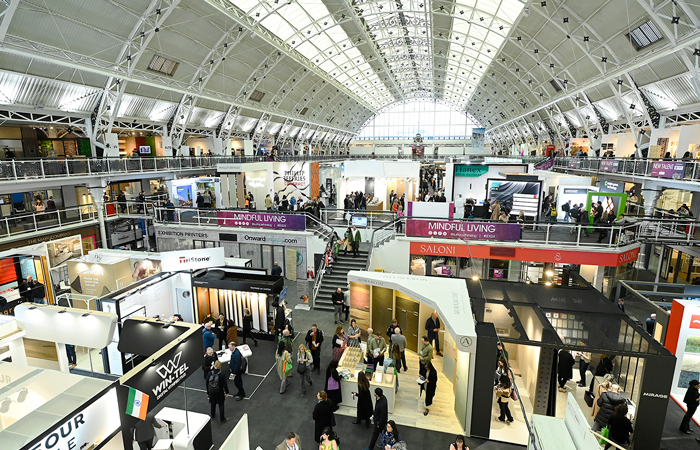
It’s made all the more appealing by the consistent content that the show has to offer, which is in itself a unique contribution to the annual rostrum of UK-based trade events. Its strength lies in its specificity to materials and surfaces for the built environment; the lifeblood of any architectural or interior project. This year, over 180 exhibitors, including 60 international companies from 17 countries, took part in the show, bringing with them a host of materials and surface solutions.
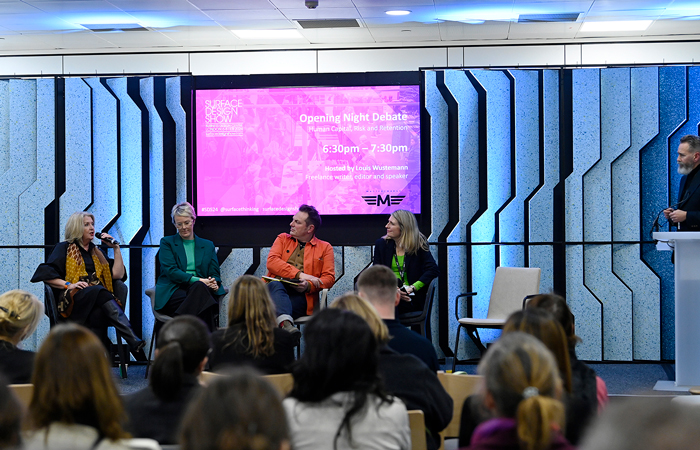
As ever, the 6000+ visitors were spoilt for choice in terms of viewing and listening opportunities, with the varied and engaging speakers program returning to the Main Stage, with its stunning Smile Plastics backdrop. Design Insider’s own Alys Bryan chaired the Legends Live series, which included the likes of Tom Llyod and Matthew Hilton, while Louis Wustemann, Color Hive and Dr. Petrina Carmody among others presented their ideas, with this year’s theme Mindful Living forming the overarching topics for discussion. Elsewhere, Sally Angharad returned to curate the Surface Spotlight exhibit, which showcases a selection of the latest material innovations around, while the New Talent section offered visitors a chance to discover some of the next generation of surface stars.
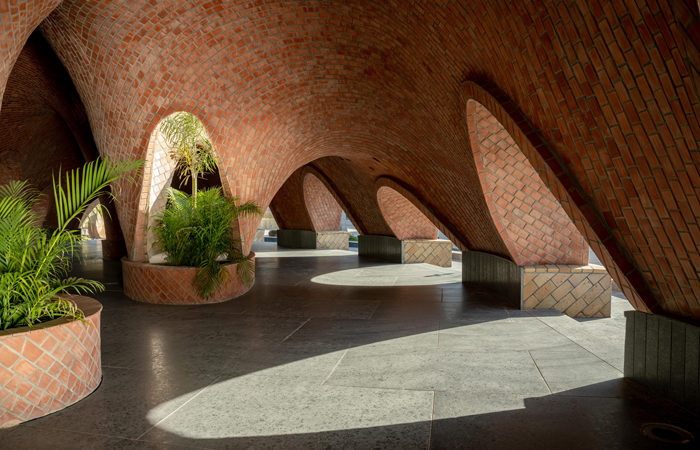
Grid Architects, awarded the Light and Surface Interior for the Tarang Pavilion
The hotly anticipated Surface Design Awards returned with a stellar line-up of shortlisted projects whittled down from the 160 entries that came in from an unprecedented 20 countries. This year the Supreme Winner, Grid Architects, also took the Light and Surface Interior for the Tarang Pavilion and underlined India’s ascendency as both an economic and architectural force. The arched terracotta brick-built structure takes its name from the word ‘wave’ in Hindu and is designed to offer adaptability as an immersive gallery space, with a 3-dimensional form that accentuates light and shadow that the judges praised as “a true beauty of interior spaces (that) connect to the whole construction.”
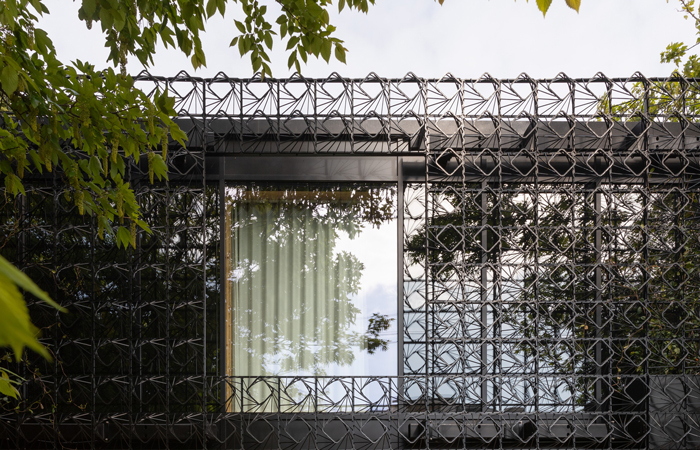
Giles Miller Studio awarded Exterior Surface award for Woven
Giles Miller Studio took the Exterior Surface award for Woven, a homestead in Broadstairs, Kent, that combines 3-Dimensional form and nature to create what the judges described as “clear craftsmanship with biophilia cleverly being used out of context.” Square modules made from recycled plastic have spindles that are raised and twisted across 2 levels creating an open structure through which jasmine and wisteria are interwoven. Not only does this outer shell, which encases an internal glass and steel box, create some privacy and shade but it also means the building will evolve and change from month to month, and indeed over the years to come.

Tonkin Liu awarded Light and Surface Exterior for Sunderdea Sunderland scheme
The awards also celebrate how structures interact and play with light, a sometimes subtle, perhaps even overlooked, yet potentially highly emotive quality in the built environment. Tonkin Liu won the Light and Surface Exterior accolade for their Sunderdea Sunderland scheme, which celebrates the city’s maritime past with a wave design that ripples across the intricately perforated surface. Indeed the visual effect is actively designed to change from day to night, as well as passively twinkling with the reflection of car headlights, a fitting backdrop for a place known as the City of Light.
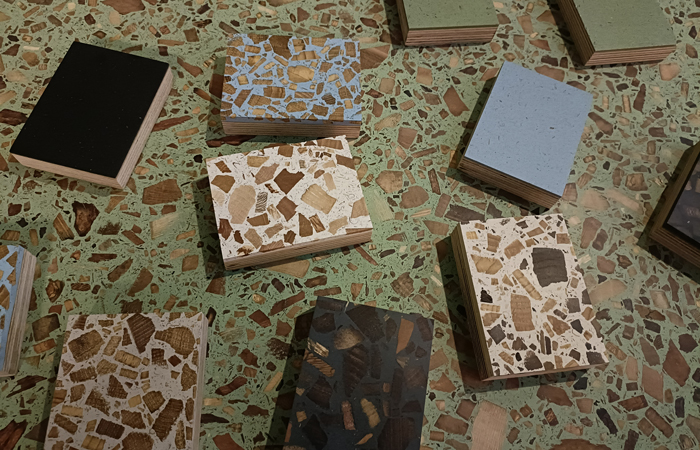
Foresso
Of course, a major reason to visit the show is to explore and get one’s hands on material samples, be they stone, wood, plastic, plaster, biomaterials, or any number of composite to mention but a few. Midlands-based low-carbon manufacturer Foresso bought an appealing sage green stand to the event, on which the various ingredients that make up its now relatively infamous wood terrazzo were displayed. Samples included those with large chips of unavoidable waste timber set in coloured bio-resin that we’ve seen pop up at various shows and interior schemes over the past number of years, alongside the comparatively newer No-Chip range. Where standard Foresso uses chunks of waste wood, this more visually delicate surface utilises the extraction waste produced in the making of all materials fabricated in the workshop, thus closing the loop on the entire process.

KH, Inocra range
Another company concerned with using waste, albeit from much further afield, is KH Exports India. While tucked away in the back corner of the event, the alluring and intriguing samples on display cried out for attention. Leather specialists by trade, producing high-quality materials for fashion and footwear industries predominantly, the Inocra range salvages cutting wastage from the factory floor and transforms it into fused surfaces for decorative interior applications. Several patterns, colourways and textures are available, with each newly crafted material beautifully drawing attention to its recycled nature while offering a truly unique design.

Opus Artis
Stone is a mainstay of the event, which is underlined by the permanent fixture that is the Stone Gallery, which this year offered an installation titled Stone Tapestry: Beyond the Surface as its centre piece. First-time exhibitors Opus Artis specialise in stone, notably hand-inlaid designs that often combine metal finishes, which add a further touch of style and luxury to the skilfully patterned outcomes.
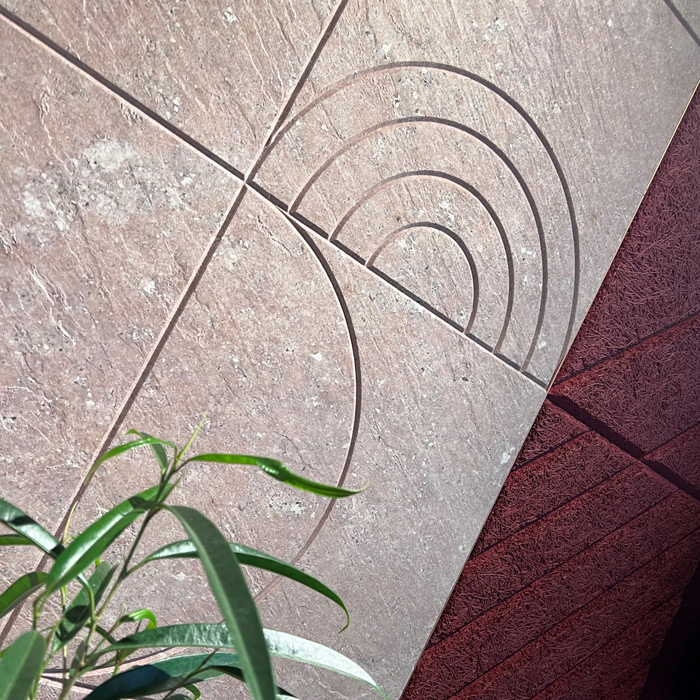
Artworks, ALTO panels
One company, and indeed application, that you wouldn’t immediately associate with stone is Artworks, whose primary product offering are acoustic solutions. The company is known for its ALTO panels, which consist of 100% polyester made up of 60% post-consumer recycled content that can be CNC cut and engraved. While you may be forgiven for thinking that stone would offer worse acoustic properties, the XSTONE range, which includes a top layer of laminated stone, proves otherwise. Tests have shown that all the various finishes applied to the standard 12mm ALTO panels actually improve the acoustic performance of the product, meaning one could apply a lightweight stone surface to walls or even the ceiling safe in the knowledge they will sound as well as look fantastic.





